This post may contain affiliate links. Please read our disclosure policy.
Are you looking for a quick and delightful addition to your desserts? This small batch Lemon Curd recipe is just the thing! It’s a sweet, tart, and velvety smooth concoction that’s ready in minutes. Using fresh lemons, this recipe brings a burst of natural, tangy sweetness to any dish. Whether spread on toast, used as a topping, a filling, or even enjoyed straight from the spoon, this lemon curd is a versatile and delightful treat. With easy step-by-step instructions, even beginners can whip up this delicious treat.
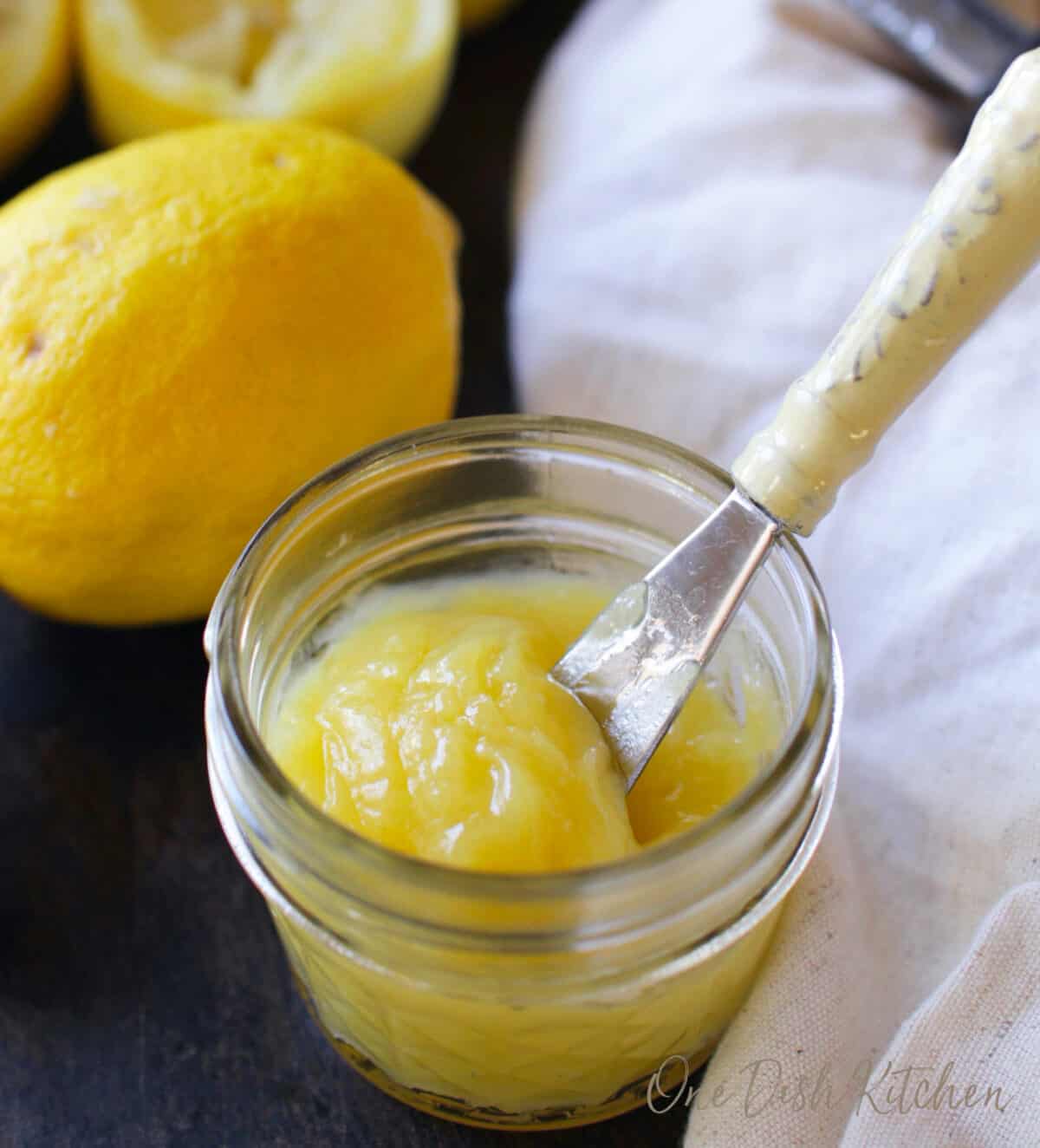
Indulge in your homemade lemon curd by swirling it into plain or Greek yogurt, topped with a sprinkle of Butter Pecan Granola. Alternatively, spread it over freshly-baked Cream Scones, use it as a delightful topping for a White Cake, or fill a mini Graham Cracker Crust with it to create an elegant tart.
Why You’ll Love This Recipe
- Ease of Preparation: No advanced cooking skills needed, just simple stirring and whisking!
- Bright & Zesty Flavor: Lemon curd adds a burst of fresh, tangy sweetness to any dessert.
- Versatile Use: It’s perfect as a spread, a topping, a filling, or eaten right off the spoon.
- Small Batch Convenience: This recipe makes just the right amount to enjoy now and save for later.
- No Artificial Colors or Flavors: With fresh lemon juice and zest, enjoy the pure, natural taste of lemons.
RELATED: 25 Single Serving Summer Recipes
What Is Lemon Curd?
Lemon curd is a delightfully tangy and creamy spread, renowned for its bright citrus flavor and smooth texture. Originating in England, this versatile condiment has become a favorite worldwide, especially for enhancing desserts. Our special small batch recipe takes this classic to a new level of convenience and simplicity. It’s designed to produce just the right amount for personal use or small gatherings, ensuring you get the freshest taste without any waste. This lemon curd recipe combines fresh lemon juice and zest, sugar, butter, and an egg, cooked to perfection to create a rich, velvety spread that’s ideal for a variety of uses. Perfect for those who appreciate the zesty punch of lemon in a convenient, easy-to-make portion.

Ingredients
If you have any ingredients leftover from this lemon curd recipe, check out our Leftover Ingredients Recipe Finder.
The recipe yields about 1/4 cup.
- Sugar: Adds sweetness and balances the tartness of the lemons. Use granulated sugar for the best texture.
- Butter: Gives the curd its creamy consistency.
- Egg: Thickens the curd and adds richness.
- Lemon Juice: The star ingredient, providing the tartness. Freshly squeezed juice is best for flavor.
- Lemon Zest: Enhances the lemony flavor. Ensure it’s only the yellow part to avoid bitterness.
Recipe Variations
Experiment with these lemon curd variations:
- Lime Curd: Replace lemon juice and zest with lime for a “Lime Zest Curd.” This version brings a unique, zesty twist, perfect for those who enjoy a slightly different citrus flavor.
- Sweet Orange Curd: For an “Orange Curd,” substitute lemons with oranges. The result is a sweeter, less tart curd, ideal for those who prefer a milder citrus taste.
- Mixed Citrus Curd: Combine lemon, lime, and orange juices and zests to create a “Citrus Medley Curd.” This blend offers a harmonious mix of tart and sweet flavors, creating a multifaceted citrus experience.
- Ginger Lemon Curd: Add a quarter-teaspoon of finely grated ginger to the basic recipe for a “Ginger Lemon Curd.” This adds a warm, spicy kick, perfect for adding a bit of zing to your curd.
How To Make Lemon Curd
This section will help you visualize how to make a small batch of lemon curd. See the recipe box below for ingredient amounts and full recipe instructions.
Important Note: Making lemon curd involves gently heating the ingredients on the stove to achieve a thick and smooth consistency. This process is quick, and with my special technique, you can ensure your lemon curd turns out exceptionally smooth, avoiding the common issue of cooked, curdled egg pieces in the curd.
- Begin by creaming the sugar and softened butter in a bowl using an electric mixer, just as you would for a cake or cookies. Mix until the blend is fluffy, then gradually add the egg, followed by the lemon juice and zest.
Common Question:
Why cream the butter and sugar together if you’re about to melt them over heat? While it may seem like an unnecessary step before melting everything together, creaming the butter and sugar in lemon curd actually serves several important purposes. Firstly, it creates a smooth and silky texture by trapping tiny air bubbles, which prevent the curd from becoming dense and heavy. Secondly, creaming helps emulsify the butter and the acidic lemon juice, ensuring a stable and homogenous curd that won’t separate. Finally, it can even slightly enhance the flavor by incorporating the oils from the lemon zest into the butter. Although the heat will eventually melt the sugar and butter, this initial creaming step plays a crucial role in achieving the desired texture, stability, and flavor profile of the finished lemon curd.
Note: At this point, the mixture might look somewhat unusual, but don’t worry. Once it’s heated, it will transform.
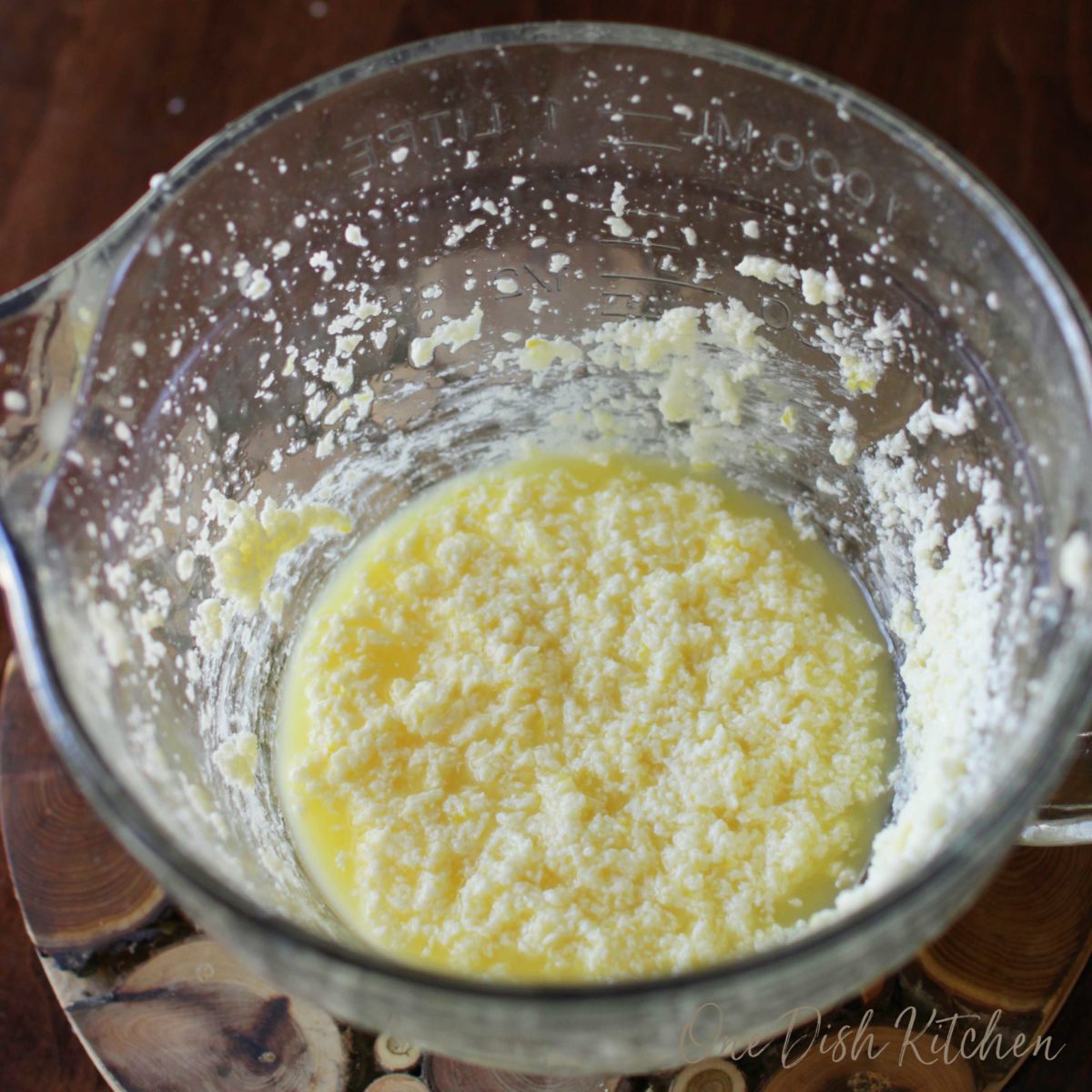
- Pour the mixture into a 1-quart saucepan. Cook it over medium-low heat, whisking frequently. This should take around 10 minutes. You’ll notice the mixture thickening and smoothing out, losing any curdled texture it had before, resulting in a silky-smooth lemon curd.
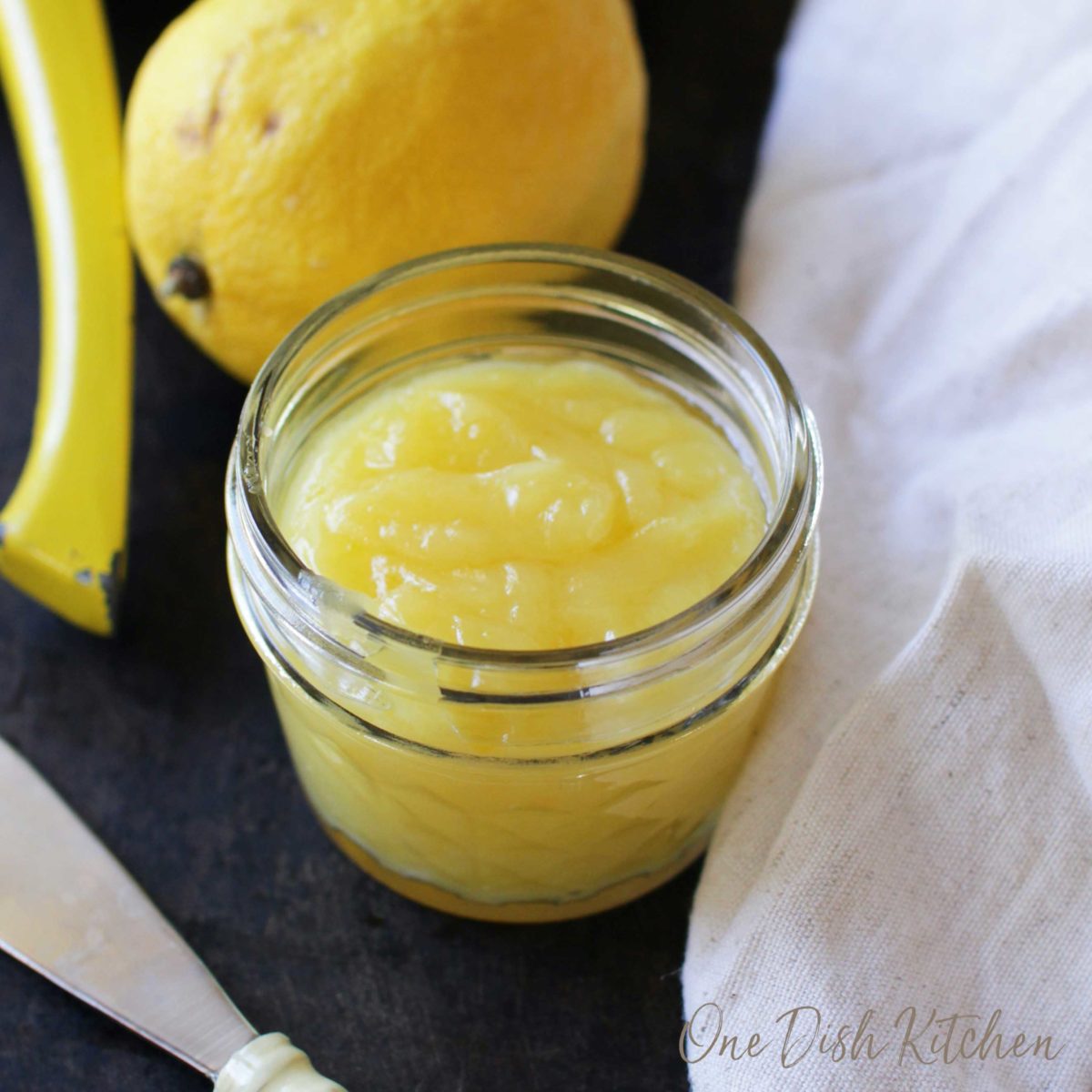
RELATED: The Best Small Batch Cookie Recipes
Expert Tips
- Constant Stirring: Keep stirring the mixture while cooking to avoid curdling.
- Low Heat: Cook the curd over low heat to prevent eggs from scrambling.
- Strain for Smoothness: Strain the finished curd through a fine mesh for a silky texture.
- Fresh Lemons: Use fresh lemons rather than bottled juice for a brighter flavor.
- Jar Storage: Store in a clean jar and refrigerate to prolong freshness.
Frequently Asked Questions
It may be due to overheating or not whisking enough. Remember to whisk constantly and maintain low heat.
Store in an airtight container in the fridge. It will last up to 2 weeks.
Yes, it can be frozen in an airtight, freezer-safe container. It will last for 2 months. Thaw in the refrigerator overnight before using.
Absolutely! Substitute lemon juice and zest with other citrus fruits like lime, orange, or grapefruit for a unique twist.
RELATED: The Best Homemade Food Gifts
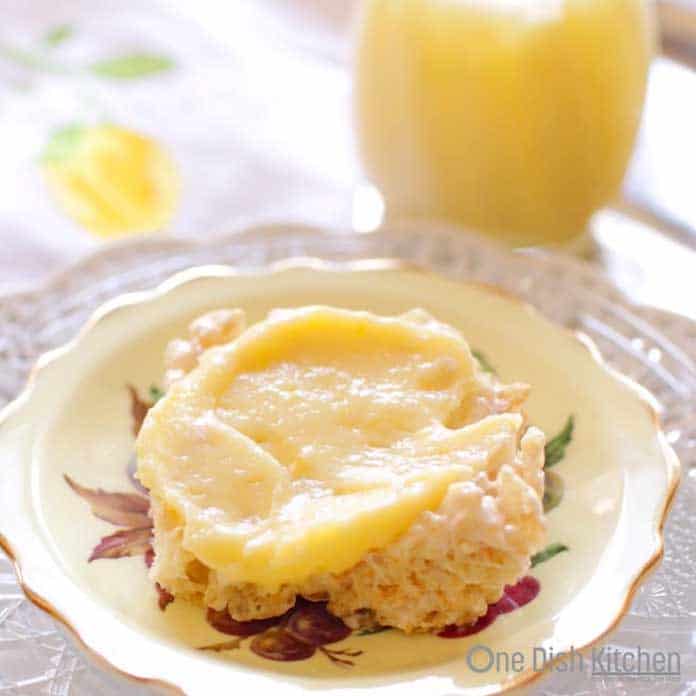
Explore More Lemon Recipes
RELATED: 15 Easy Dessert Recipes For One
If you’ve tried this small batch lemon curd recipe or any recipe on One Dish Kitchen please let me know how you liked it by rating the recipe and telling me about it in the comment section below.
If you take a picture please tag us on Instagram (@onedishkitchen) we’d love to see it!
Small Batch Lemon Curd
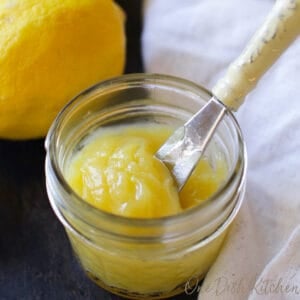
Equipment
Ingredients
- ¼ cup sugar
- 3 tablespoon salted butter , softened
- 1 large egg
- ¼ cup fresh lemon juice
- 1 teaspoon lemon zest
Instructions
- In a small bowl, beat sugar and butter together with an electric mixer, 2 minutes.
- Add egg and beat for 1 minute more.
- Mix in lemon juice and lemon zest. The mixture will look curdled, but will become smooth as it cooks.
- Pour mixture into a 1-quart saucepan and cook over a medium low heat, whisking frequently, until curd is thick and curdled appearance disappears, 10-12 minutes. Do not let the curd boil.
- Remove curd from the heat and transfer to a bowl or jar. Cover with plastic wrap and chill until cold, 1 hour.
Notes
- Whisk Constantly: This prevents the egg from curdling.
- Low Heat: Cook the curd over low heat to ensure that it doesn’t burn or turn grainy.
- Strain the Curd: For a smoother curd, strain it to remove any bits of cooked egg or large pieces of zest.
- Cool Completely: Let the curd cool before using it in any recipe, as it thickens further when cooled.
Nutrition
The information shown is an estimate provided by an online nutrition calculator. It should not be considered a substitute for a professional nutritionist’s advice.
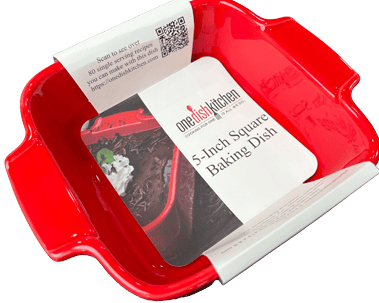









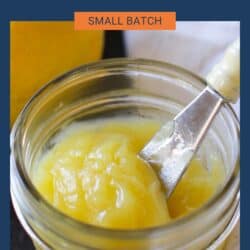
Wonderful recipe! I made a double batch and can’t get enough of it. Thanks!
I was wondering — why cream the butter and sugar together if you’re about to melt them over heat? My understanding was that creaming those ingredients is generally done to (a) evenly disperse the sugar, and (b) incorporating more air, but, the heating is about to take care of or negate the need for either of those. What am I missing? 😀
You’re right about creaming’s usual purpose in baking, but in lemon curd, creaming creates a smooth and silky texture in the finished curd. The tiny air bubbles trapped during creaming help prevent a dense and heavy texture.The process also helps emulsify the butter and the acidic lemon juice. This prevents the mixture from separating and ensures a stable and homogenous curd and finally, creaming can slightly enhance the flavor by incorporating the lemon zest’s oils into the fat (butter).
While the final cooking does melt the sugar and soften the butter, the initial creaming step plays a crucial role in achieving the desired texture, stability, and flavor profile of lemon curd.
Terrific recipe.
I love lemon curd except sometimes it tastes “eggy” to me. Somebody mentioned that this will not happen if you use ***only the yolk***; it’s the white that tastes eggy. Is this true?
Lemon curd should not taste “eggy”. If this happens, perhaps the eggs were overcooked.
Great recipe, and really easy to whip up a batch. Also works really well with limes, and even mandarin oranges.
I’m so glad you love the recipe. Thank you for your feedback.
I have no fresh lemons to make juice and it’s a ways to the market……can bottled be used in a pinch?
Yes, bottled is fine.
Can I use this in between layers of coconut cake?
Yes, that’s a delicious idea!
I was looking for a small portion of lemon curd and found this recipe and it’s great. also, this is the first time I do lemon curd.
Hi Joanie — I want u to know I saw this recipe on Pinterest awhile back, and specifically went to look for it again (I hadn’t pinned it) and what an awesome idea — the small batch is perfect, I needed to whip up a bit for Indian Chicken Biriyani – of all things — thank you again.
Forgot to say that I tried it in the microwave and worked brilliantly! just sit and keep an eye on it – whisk frequently.
I’m so glad you enjoyed the recipe. Thank you, Jan!
Joanie, this would make a great Christmas gift along with the recipe on a card. Can this be made and sent through the mail?
It would make a great gift, Nancy but lemon curd made this way needs to be refrigerated. I don’t recommend sending it through the mail.
How much of each ingredient?
Teressa,
The ingredient amounts are listed in the recipe box.
Joanie